Being a “prepare for bad things” sort of fellow, you might not be surprised to learn that I follow not just SurvivalBlog, but also several other blogs, oriented toward Bad Times, and how they might manifest themselves.
Folks who have given this topic any sort of lengthy thought realize that “Bad Times” may come in what we might consider several “flavors”. Of course, there is the Nuclear Armageddon/Zombie Apocalypse sort of Bad Times. On the other hand, more likely is the potential for much more localized Bad Times. For example, there is the “Motorcyclist dumped his bike in front of us on the expressway” sort of event. Or, the “Don’t chop wood, camping, when you are tired or distracted” sort of thing, wherein you discover things about the interior anatomy of your ankle that you really would just as soon not learn.
Advice From Two Bloggers
Of course, being an Old Medic, I have “medic bags” in our vehicles as well as in our home. I had thought I was pretty well set, until I read an interchange between two great bloggers, Commander Zero, of the Notes From The Bunker blog, and Aesop, of Raconteur Report.
Commander Zero (“CZ”) noted that he had packed his own first aid kit in mylar after an experience of leaving his kit out, all winter long, in a fabric bicycle bag. Bad outcome. His goal was to forestall the conjuring up of the Ghost of Murphy (and his famous law).
Commander Zero’s adventures are documented in First Aid Kit Foibles from March 8, 2015, and an assessment recorded on September 4, 2019.
That post (Mar 8, 2015) elicited the following response in Notes From The Bunker from Aesop, of Raconteur Report
Aesop on March 17, 2015 at 1:17 AM said:
1. Any FA kit that isn’t waterproof is worthless. If not now, then when you need it, which is worse. As you’ve discovered, and as I did the first time I was working on a movie set on a rainy day. It’s a mistake you only make once.
2. Mylar is nice, but you can’t see what’s inside. Consider heavy-duty Saran wrap or equiv. as something still see-through, but easier to tear open than mylar or two-hand zip-loks.
3. If you’re any kind of handy with a sewing machine, turning mil-spec poncho materials into pack and bag condoms is a quick and elegant way to make your favorite bag far more water resistant. It also gives you options as far as external appearance, whether more camo’ed, or more non-descript than Tactical Timmy camo patterns in urban use around the unprepared muggles. YMMV.
4. Given your penchants anyways, you can get single-use heat seal clear plastic bagging material too, and simply resolve that if you tear something open for use, you’ll re-stock and re-seal it at the first opportunity.
5. As far as opening, putting a guard-protected single-edge razor or retractable box cutter in the top of the kit is never a bad idea. For some of the sterile wrap cr*p used in the ED, I need bandage scissors, trauma shears, and/or a hemostat (think ER pliers) just to open the blasted packaging, and that’s indoors in air-conditioned comfort, with two hands.
6. As a general rule, whether for first aid or any other kind of kit, anything that couldn’t be reliably used during a year’s service in the WWI trenches of the Somme probably isn’t proper kit to rely on, and you’ll find that out at the worst possible moment. Field-test your gear and eliminate the flaws now, when mistakes are free.
7. Just random curiosity, but for a bike kit, why not something along the lines of a screw-top or screw-twist together PVC pipe or somesuch thing, clamped/strapped/zip-tied/etc. to the frame? Bombproof, compact, and totally watertight, and you could size the tube diameter to the largest items, and adjust the length so everything fits. Just thinking out loud there.
Since I am not particularly smart (but I do listen to folks who are!), the project that I am about to describe is entirely derivative.
My usual practice is to pull, empty, inspect, repack and/or replace the contents of my medic bags/kits roughly every six months. Last repack found my Quick Clot to be rapidly pending out date, and, at around $15 a pop, well, two packages times three kits plus six IFAK/Blow Out Kits at one Quick Clot each, along with a couple of restock spares, quickly adds up to a sizable amount of money, money that I really think could be spent more realistically on Moar Ammo!
Whatever. That’s why I work OT, anyhow.
Making It Weatherproof
With Commander Zero’s experience and Aesop’s insights, this time around, I moved to increase the weather resistance of my kits. The following photos illustrate:
Picture One: Before: contents laid out on a handy table in my basement. Notice the nylon L. A Police Gear “Bail Out Bag”, which serves as my medic bag. Not waterproof. Notice, as well, that the contents laid out on the table are, themselves, not waterproof.
Picture Two: Here is how it had been packed in my bag, before. Kinda organized, yes. Waterproof? Not so much! And, while to date (some 45 years, more or less) it has not let me down, consider that I have not needed it during a rainy weekend field exercise. Or, for that matter, for reals in an Oobleck storm.
Picture Three: Example of the gauze and ABD dressings, vacuum-sealed (with a Foodsaver.) I also purchased a dozen inexpensive retractable blade razor knives, secured with a lanyard to the inside of the bag, for ease of opening. (see below)
Picture Four: After. Medic bag, with IFAK/Blowout Bag attached to the handle. The Sharpie writing (arrowhead) says, “BVM”, as an indication that the Bag Valve Mask, or manual resuscitator, is inside.
Picture Five: In order to be certain that I can open the gauze, or the ABDs, or whatever, when my elderly fingers are cold, or stiff, or slippery with (insert disgusting bodily fluid, here), following Aesop’s suggestion I have included a retractable razor knife. (about a buck each at my neighborhood hardware store).
Picture Six: The orange duct tape allows me to dummy cord the knife to my pack, so that, since my aforementioned elderly fingers may be cold, or stiff, or slippery with whatever bodily fluid you selected above, it will be more difficult to have the knife slip from my hand, and get lost in the (dark)(mud)(other). If you are clever enough to read SurvivalBlog, Raconteur Report, or Notes From The Bunker blog, you can figure out the lanyard thing yourself. I looped some 550 cord through the tape loop, and then looped said 550 cord through a knotted loop of elastic cord the manufacturer thoughtfully provided inside the bag.
(To be concluded tomorrow, in Part 2.)

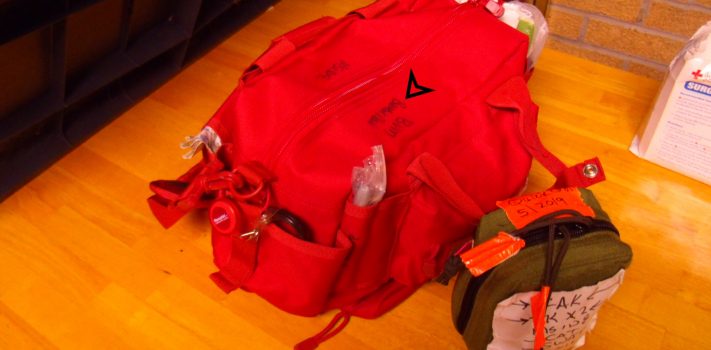









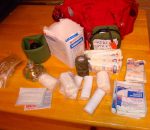
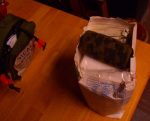
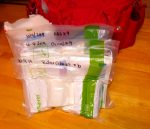
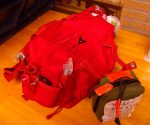
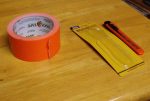
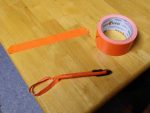
My limited experience with injuries include:
* thrashing
* potty-mouth at high-volumes
* barfing
* grabbing my clothes/extremities/hair simultaneously while clawing my eyes
* defecation
* unconsciousness turning the vic into wet-noodle deadweight
* and the potential of losing the vic.
I would never not do my Good Samarian best… my presence always makes a diff.
But my skills may not be enough.
And I always own the call of quitting the rescue.
I am no good to anybody if I become another vic.
Examples:
* a drowning person will most definitely try to drown me… quite energetically.
* a student pilot is a homicidal maniac with murderous intent for instructors.
* a vehicle crash is a war-zone — traffic will try to drive over me from all directions… including overhead.
I never donate my warm clothes to a vic on an icy mountain.
The rescue may leave me stranded — overnight in weather — while I watch my jacket/radio/fire-starter disappear on the helicopter.
What else?
I do my job, I don’t do it for medals or adoring reporters or holiday cards from the grateful vic.
What else?
Equipment helps skills.
Rehearsal helps skills.
Continuing Education helps skills.
Cross-Training helps skills.
Experience helps skills.
Playing the vic helps skills.
Teaching helps skills.
Watching old-timers helps skills.
Placing medic bag items in Food Saver bags is a great idea, but costly. Food saver bags are way over priced for the quantity you get. Your better bet would be to go to Cabelas and purchase their patented vacuum-seal bags. They come in various sizes and rolls to make your own custom size. You can get a box of one hundred 6″x 10″ for ~$15. Plus these bags have a notch on the side that assists with ripping the bag open. That might be far better than trying to use a knife or razor in a stressful situation.
Peace.
Love this look! Always good to see others approaches, always!
Mine is –
A solid nylon bag, use silicone tent/canvas spray, to make it water resistant, and seal small items in heavy duty ziplock- we use this for our tents and tarps so we have a bit!,
We keep everything individually wrapped in ziploc bags inside a (purportedly) waterproof case. A lot of the items we get into periodically (bandaids, painkillers, neosporin, etc), so I wouldn’t want to seal them with Foodsaver wrap, but there are other items we rarely use (roll gauze) that take up a lot of room and will be more compact. Will give it a try 🙂
Large Marge: And, skills help you extemporize when supplies like in The Book, are not at hand.
Mtnman 1958: Thank you for the Cabela’s tip. Next field trip, look-see!
JustADad: More one way to do it. This is an evolution from the venerable Tackle-Box-as-first-aid-kit. After I had tipped a tackle box, a time or three, on a scene, the bag-over-my-shoulder idea began to appear more attractive.
No kidding on the cabelas tip. I’m going to look online first since the closest one is an hour away and traffic around here is pretty bad right now.
Amen to the bag/vs/ box, I do have a larger kit that resides in the vehicle in trips and house that is boxed. But, all smaller bags, are, bags! Agreed 100! Again, loved this article and just read its companion piece!